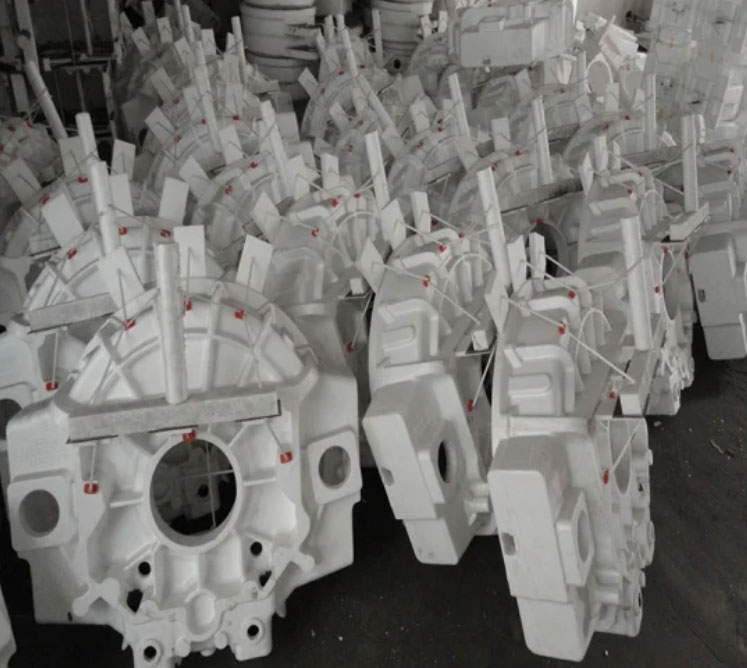Lost foam casting (LFC), an evolution of full-mold casting, has undergone transformative advancements since the development of China’s first production line by the Chinese Academy of Sciences in 1981. Over four decades, innovations in process optimization, equipment design, mold engineering, and material science have solidified its position as a sustainable and cost-effective manufacturing method. This article explores the technical foundations, workflow innovations, and critical engineering considerations that define modern LFC systems.

Core Process Characteristics
The lost foam casting process employs expandable polystyrene (EPS) or copolymer patterns that vaporize during metal pouring, creating precise cavity formations in dry sand molds. Key advantages over conventional sand casting include:
- Complex geometry capability: Enables production of components with intricate internal channels and undercuts
- Environmental efficiency: Eliminates core-making emissions and achieves 90% sand reclamation
- Economic benefits: Reduces machining allowances by 40-60% and decreases overall production costs by 30%
The energy consumption profile demonstrates significant improvements:
$$E_{LFC} = E_{sand} \times (1 – \eta_{reclaim}) + E_{pattern}$$
Where ηreclaim represents the sand reuse rate (≥0.9), resulting in 15-20% lower energy intensity compared to traditional methods.
Production Workflow Architecture
Modern LFC facilities organize operations into three distinct zones:
| Zone | Function | Key Processes |
|---|---|---|
| White Area | Pattern Production | Bead expansion, molding, aging |
| Gray Area | Pattern Processing | Coating, drying, assembly |
| Black Area | Metal Casting | Melting, molding, pouring |
The pattern manufacturing sequence follows critical thermal parameters:
- Pre-expansion: Steam activation at 100-110°C
- Maturation: Stabilization period (t ≥ 4hr)
- Molding: Steam pressure (P = 0.15-0.25MPa)
- Coating: Multiple dipping cycles with refractory slurry
Advanced Engineering Design Framework
Optimal facility layout separates flammable pattern production (Class C fire hazard) from foundry operations (Class D) to minimize fire protection costs. Key design parameters include:
| Parameter | White Area | Black Area |
|---|---|---|
| Floor Height | 4.5-6m (multi-level) | 12-18m (single span) |
| HVAC Requirements | 10-15 air changes/hr | 5-8 air changes/hr |
| Material Storage | <5% total area | 15-20% total area |
The vibration compaction process employs dynamic modeling:
$$a_{vib} = \frac{4\pi^2 f^2 A}{g}$$
Where f = 50-70Hz vibration frequency, A = 0.5-1.5mm amplitude, and g = gravitational acceleration. This ensures optimal sand density (1.55-1.65g/cm³) with minimal pattern distortion.
Material Science Considerations
Advanced bead materials demonstrate distinct thermal decomposition characteristics:
$$t_{vaporization} = \int_{T_{pour}}^{T_{decomp}} \frac{\rho C_p}{k} \left(\frac{\partial T}{\partial t}\right) dt$$
Where ρ = material density, Cp = specific heat, and k = thermal conductivity. Current material options include:
- EPS: Tdecomp = 160-190°C (aluminum/iron)
- STMMA: Tdecomp = 210-240°C (steel alloys)
- EPMMA: Tdecomp = 280-320°C (high-temp alloys)
Environmental and Economic Impact
Comparative analysis reveals significant sustainability advantages:
| Metric | Sand Casting | Lost Foam |
|---|---|---|
| VOC Emissions (kg/t) | 8.2-12.5 | 0.3-0.8 |
| Energy Use (GJ/t) | 9.8 | 7.1 |
| Yield Improvement | Base | +18-25% |
The economic model demonstrates clear advantages:
$$C_{LFC} = C_{mat} \times (1 – \alpha) + C_{lab} \times (1 – \beta)$$
Where α = 0.3-0.4 (material savings) and β = 0.4-0.5 (labor reduction).
Future Development Trends
Emerging innovations focus on:
- AI-driven pattern optimization algorithms
- Hybrid additive manufacturing for complex cores
- Advanced vacuum control systems (ΔP ≥ 0.04MPa)
- Automated coating thickness control (0.8-1.2mm)
These advancements position lost foam casting as a cornerstone technology for sustainable manufacturing in the green economy era, particularly for electric vehicle components and renewable energy systems requiring high-integrity castings.
